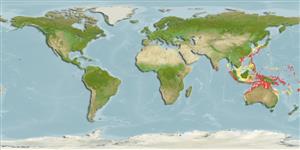Teleostei (teleosts) >
Gobiiformes (Gobies) >
Gobiidae (Gobies) > Gobiinae
Etymology: Exyrias: Derived from Greek, xyreo = to shave (Ref. 45335); akihito: Named for the Emperor of Japan; noun in apposition.
Eponymy: Emperor Akihito of Japan (d: 1933) is noted for his many contributions to goby systematics and phylogenetic research. [...] (Ref. 128868), visit book page.
More on authors: Allen & Randall.
Environment: milieu / climate zone / depth range / distribution range
Ecology
Marine; reef-associated; depth range 10 - 50 m (Ref. 57733). Tropical
Western Pacific: Yaeyama Is., southern Japan to the Great Barrier Reef, Australia.
Size / Weight / Age
Maturity: Lm ? range ? - ? cm
Max length : 11.1 cm SL male/unsexed; (Ref. 57733)
Short description
Identification keys | Morphology | Morphometrics
Dorsal spines (total): 7; Dorsal soft rays (total): 10; Anal spines: 1; Anal soft rays: 9. Diagnosis: Color generally light bluish grey in life with small yellow to brownish orange spots on the head and body, those on body mostly conjoined to form longitudinal stripes along scale rows; 4 pairs of dark brown spots on lower side of body, followed by a single spot at the caudal-fin base; a few smaller dark brown spots on body, mostly in a row dorsally and one ventrally; dorsal and caudal fins are covered with numerous, relatively large, orangish to yellowish brown spots. Pectoral rays 17; segmented caudal-fin rays 17; branched caudal-fin rays typically 13, rarely 12, 14 or 15; dorsal-fin spines elongate and filamentous, the second one the longest 1.59-2.07 in SL. Longitudinal scale series 28 (28-30).
Usually found in clear water in the vicinity of coral reefs, usually on sand or rubble bottoms (Ref. 57733). Solitary (Ref. 90102).
Life cycle and mating behavior
Maturity | Reproduction | Spawning | Eggs | Fecundity | Larvae
Allen, G.R. and J.E. Randall, 2005. Exyrias akihito, a new species of coral-reef goby (Gobiidae) from the Western Pacific. Raffles Bull. Zool. 53(2):231-235. (Ref. 57733)
IUCN Red List Status (Ref. 130435: Version 2024-2)
Threat to humans
Harmless
Human uses
Tools
Special reports
Download XML
Internet sources
Estimates based on models
Preferred temperature (Ref.
123201): 25.3 - 28.9, mean 27.7 °C (based on 290 cells).
Phylogenetic diversity index (Ref.
82804): PD
50 = 0.5312 [Uniqueness, from 0.5 = low to 2.0 = high].
Bayesian length-weight: a=0.01023 (0.00477 - 0.02194), b=3.01 (2.83 - 3.19), in cm total length, based on LWR estimates for this (Sub)family-body shape (Ref.
93245).
Trophic level (Ref.
69278): 3.1 ±0.4 se; based on size and trophs of closest relatives
Resilience (Ref.
120179): High, minimum population doubling time less than 15 months (Preliminary K or Fecundity.).
Fishing Vulnerability (Ref.
59153): Low vulnerability (10 of 100).
